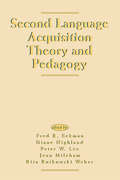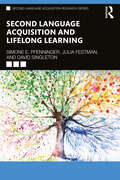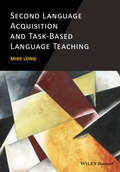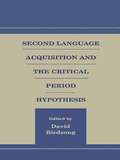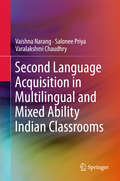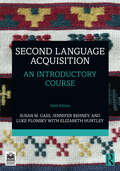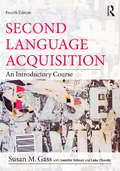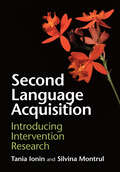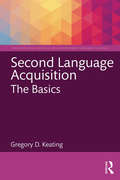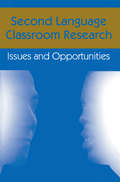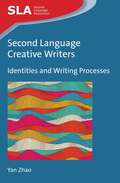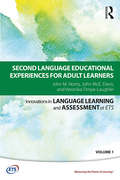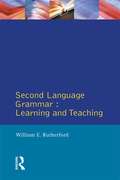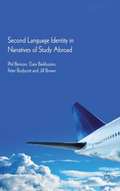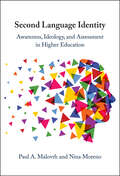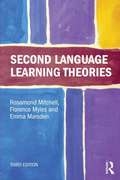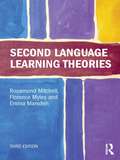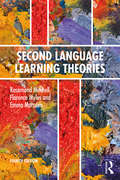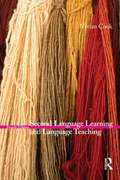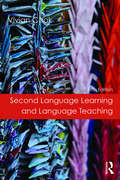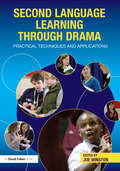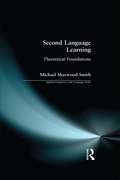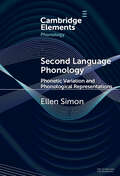- Table View
- List View
Second Language Acquisition Theory and Pedagogy
by Fred R. Eckman Diane Highland Peter W. Lee Jean Mileham Rita Rutkowski WeberA volume on second-language acquisition theory and pedagogy is, at the same time, a mark of progress and a bit of an anomaly. The progress is shown by the fact that the two disciplines have established themselves as areas of study not only distinct from each other, but also different from linguistic theory. This was not always the case, at least not in the United States. The anomaly results from the fact that this book deals with the relationship between L2 theory and pedagogy despite the conclusion that there is currently no widely-accepted theory of SLA. Grouped into five sections, the papers in this volume: * consider questions about L2 theory and pedagogy at the macro-level, from the standpoint of the L2 setting; * consider input in terms of factors which are internal to the learner; * examine the question of external factors affecting the input, such as the issue of whether points of grammar can be explicitly taught; * deal with questions of certain complex, linguistic behaviors and the various external and social variables that influence learners; and * discuss issues surrounding the teaching of pronunciation factors that affect a non-native accent.
Second Language Acquisition and Lifelong Learning (Second Language Acquisition Research Series)
by David Singleton Simone E. Pfenninger Julia FestmanLanguage fundamentally defines and distinguishes us as humans, as members of society, and as individuals. As we go through life, our relationship with language and with learning shifts and changes, but it remains significant. This book is an up-to-date resource for graduate students and researchers in second language (L2) acquisition who are interested in language learning across the lifespan. The main goal is to survey and evaluate what is known about the linguistic-cognition-affect associations that occur in L2 learning from birth through senescence (passing through the stages of childhood, adolescence, adulthood, and third age), the extent to which L2 acquisition may be seen as contributing to healthy and active aging, the impact of the development of personalized, technology-enhanced communicative L2 environments, and how these phenomena are to be approached scientifically and methodologically. The effects of certain specific variables, such as gender, socio-economic background, and bilingualism are also analyzed, as we argue that chronological age does not determine the positioning of L2 learners across the lifespan: age is part of a complex web of social distinctions such as psychological and individual factors that intersect in the construction of a learner’s relative status and opportunities.
Second Language Acquisition and Task-Based Language Teaching
by Mike LongThis book offers an in-depth explanation of Task-Based Language Teaching (TBLT) and the methods necessary to implement it in the language classroom successfully. Combines a survey of theory and research in instructed second language acquisition (ISLA) with insights from language teaching and the philosophy of education Details best practice for TBLT programs, including discussion of learner needs and means analysis; syllabus design; materials writing; choice of methodological principles and pedagogic procedures; criterion-referenced, task-based performance assessment; and program evaluation Written by an esteemed scholar of second language acquisition with over 30 years of research and classroom experience Considers diffusion of innovation in education and the potential impact of TBLT on foreign and second language learning
Second Language Acquisition and the Critical Period Hypothesis (Second Language Acquisition Research Series)
by David BirdsongSecond Language Acquisition and the Critical Period Hypothesis is the only book on the market to provide a diverse collection of perspectives, from experienced researchers, on the role of the Critical Period Hypothesis in second language acquisition. It is widely believed that age effects in both first and second language acquisition are developmental in nature, with native levels of attainment in both to be though possible only if learning began before the closure of a "window of opportunity" – a critical or sensitive period. These seven chapters explore this idea at length, with each contribution acting as an authoritative look at various domains of inquiry in second language acquisition, including syntax, morphology, phonetics/phonology, Universal Grammar, and neurofunctional factors. By presenting readers with an evenly-balanced take on the topic with viewpoints both for and against the Critical Period Hypothesis, this book is the ideal guide to understanding this critical body of research in SLA, for students and researchers in Applied Linguistics and Second Language Acquisition.
Second Language Acquisition in Multilingual and Mixed Ability Indian Classrooms
by Vaishna Narang Salonee Priya Varalakshmi ChaudhryThis book discusses current research on learning theories and pedagogical practices in second language acquisition, and tries to bridge the gap between the two. Second language acquisition is perceived as the study of the relationship between input, intake and output in a particular task performance, and Indian classrooms are the context for the research studies in this book. The empirical studies discussed in this book are based on two tasks: seminar speech task (SST) and written test performance task (WTPT). The pedagogical practices discussed cover three specific areas: tasks, skills, and strategies. The study focuses on text input processing for written versus spoken tasks, at various levels of task performance, and for language versus information. The authors discuss, among other issues, various elements of second language speech production, teachers' evaluation of communicative versus form-focused tasks, and task-based versus proficiency-based performance. As a study located in multilingual and mixed ability classrooms, this work provides immense insights to teacher-educators and researchers working in ESL settings with learners from diverse backgrounds.
Second Language Acquisition: An Introductory Course
by Susan M. Gass Jennifer Behney Luke Plonsky Elizabeth HuntleyNow in its sixth edition, this bestselling textbook remains the cornerstone for the study of second language acquisition, providing a comprehensive yet accessible introduction to SLA.This substantially revised and updated edition has been edited into ten chapters, with a focus on the most frequently taught core themes and increased accessibility. A new introductory chapter provides a concise overview of the history of the field. Omitted chapters are available online where supplementation is desired. The text continues to provide a rich range of pedagogical tools that encourage students to reflect upon the experiences of second language learners. As with previous editions, discussion questions and problems are peppered throughout each chapter to help students apply their knowledge, and a glossary defines and reinforces must-know terminology. Additional questions and problems appear on the online companion website.This seminal text is ideal core reading for SLA courses in second language studies, applied linguistics, linguistics, TESOL, and/or language education programs. This textbook is supported with Instructor and Student Resources, including PowerPoint slides, exercises, flashcards, audio and video links: www.routledge.com/cw/gass.
Second Language Acquisition: An Introductory Course
by Susan M. GassNow in a fourth edition, this bestselling introductory textbook remains the cornerstone volume for the study of second language acquisition (SLA). Its chapters have been fully updated, and reorganized where appropriate, to provide a comprehensive yet accessible overview of the field and its related disciplines. To reflect current developments, new sections on using learner corpora, semantics and morphosyntax (within formal approaches to SLA), sociocultural approaches, gesture, priming research, and chaos theory have been added. Students will also find expanded discussions of heritage language learning, bilingualism, pragmatics, and much more. The redesigned fourth edition of Second Language Acquisition retains the features that students found useful in the current edition but also provides new pedagogical tools that encourage students to reflect upon the experiences of second language learners. As with previous editions, discussion questions and problems at the end of each chapter help students apply their knowledge, and a glossary defines and reinforces must-know terminology. This clearly-written, comprehensive, and current textbook, by expert Sue Gass, is the ideal textbook for the introductory SLA course in second language studies, applied linguistics, linguistics, TESOL, and language education programs.
Second Language Acquisition: Introducing Intervention Research
by Silvina Montrul Tania IoninBased on classic and cutting-edge research, this textbook shows how grammatical phenomena can best be taught to second language and bilingual learners. Bringing together second language research, linguistics, pedagogical grammar, and language teaching, it demonstrates how linguistic theory and second language acquisition findings optimize classroom intervention research. The book assumes a generative approach but covers intervention studies from a variety of theoretical perspectives. Each chapter describes relevant linguistic structures, discusses core challenges, summarizes research findings, and concludes with classroom and lab-based intervention studies. The authors provide tools to help to design linguistically informed intervention studies, including discussion questions, application questions, case studies, and sample interventions. Online resources feature lecture slides and intervention materials, with data analysis exercises, ensuring the content is clear and ready to use. Requiring no more than a basic course in linguistics, the material serves advanced undergraduates and first-year graduate students studying applied linguistics, education, or language teaching.
Second Language Acquisition: The Basics (The Routledge E-Modules on Contemporary Language Teaching)
by Gregory D. KeatingStarting from the premise that language instruction should be informed by how humans learn language, this module on second language acquisition (SLA) aims to provide teachers at any level with a comprehensive and up-to-date introduction to the key findings about how second languages are learned in adulthood. This module explores a variety of topics including the mechanisms in the mind responsible for language acquisition, the roles that input and output play in acquisition, and how language develops in the learner’s mind over time. Furthermore, the module explores the many factors believed to impact the outcome of SLA, such as the role of the native language, individual differences in aptitude and motivation, and age of acquisition. Please visit the series companion website for more information: http://routledgetextbooks.com/textbooks/9781315679594/
Second Language Classroom Research: Issues and Opportunities (Second Language Acquisition Research Series)
by Susan Gass Jacquelyn SchachterIn an attempt to fill the gap left by the many published studies on classroom second language research, this book explores a variety of human, social, and political issues involved in the carrying out of such studies. Many journals are chock-full of the results of classroom research, with evidence to support one claim or another about the efficacy of one teaching method or another. Many textbooks are replete with statistical procedures to be used, and with experimental designs to fit varying situations. Too often overlooked in these treatments are the human, social, and political issues involved in carrying out research in classrooms that are not one's own. What are the problems going to be when one attempts work such as this? What does one do on discovering that an administrator's agenda is different than one had thought? What does one do when a teacher resents intrusions into her classroom? This book offers a view on those kinds of issues, as presented and managed by successful classroom researchers themselves. The authors present their own experiences including, on occasion, their trials and tribulations and how they dealt with them. They lay themselves open to criticism in doing so, but they make their contributions much the richer as well. The classroom contexts extend to different countries, and range from elementary schools to universities. Some of the issues presented are: * the necessarily collaborative nature of the research; * the question of meshing pedagogically sound and experimentally acceptable practices; * the often strong possibility that political and social decisions will interrupt the research; * the perennial question of reporting out the results; and * the training of graduate student researchers.
Second Language Creative Writers
by Yan ZhaoThis monograph investigates fifteen L2 creative writers' social constructive power in identity constructions. Through interviews and thinkaloud story writing sessions, the central study considers how L2 writer voices are mediated by the writers' autobiographical identities, namely, their sense of selves formulated by their previous language learning and literacy experiences. The inquiry takes the epistemological stance that L2 creative writing is simultaneously a cognitive construct and a social phenomenon and that these two are mutually inclusive. The study contributes to L2 creative writing research and L2 learner identity research and will be of benefit to researchers, language teachers and writing instructors who wish to understand creative writing processes in order to help develop their students' positive selfesteem, confidence, motivation and engagement with the L2.
Second Language Educational Experiences for Adult Learners
by John M. Norris Veronika Timpe-Laughlin John McE. DavisSecond Language Educational Experiences for Adult Learners provides an up-to-date review of the theory and practice of adult second language education. The primary objective is to introduce core ideas that should inform the design, development, and delivery of language learning experiences that take the typical forms of materials, courses, teaching, and assessment. Divided into three sections, the book first addresses what we know about adult second language acquisition and how individuals may acquire languages differently from each other. In the second section, key educational design elements—from pedagogical methods to curriculum to assessment—are then introduced from the perspective of research-based understandings about effective practices. Rounding out the volume is an overview of critical issues for language educational innovation, including supporting teachers, localizing materials and instruction, evaluating and improving education, and working with technology. Each chapter concludes with a set of recommended “design principles” that should guide readers toward high-quality, valuable, and empirically supported language educational experiences. This volume will be of interest to researchers and students investigating instructed language learning, designers creating useful language learning materials, and language teaching innovators seeking to improve outcomes in diverse instructional settings around the world.
Second Language Grammar: Learning and Teaching (Applied Linguistics and Language Study)
by William E. RutherfordThe thrust of the book is not so much upon the formation of grammatical constructs but rather upon the shape of the grammatical system and its relation to semantics, discourse and pragmatics.
Second Language Identity in Narratives of Study Abroad
by Et Al. Phil BensonStudy abroad is now both an international industry and an experience that can have a deep impact on students' attitudes and approaches to second language learning. Narratives of Second Language Identity in Study Abroad brings together three important research areas by exploring the impact of study abroad on second language identities through narrative research. It outlines a new model of second language identity that incorporates a range of language and personal competencies. The three main dimensions of this model are explored in chapters that begin with students' study abroad narratives, followed by the authors' in-depth analysis. Further chapters use narratives to assess the impact of programme type and individual difference. Arguing that second language identity development is one of the more important outcomes of study abroad, the book concludes with recommendations on how study abroad programmes can best achieve this outcome.
Second Language Identity: Awareness, Ideology, and Assessment in Higher Education
by Nina Moreno Paul A. MalovrhIncreasing globalization presents both challenges and opportunities to the higher education sector. This pioneering book shows how interaction between the two fields of foreign language pedagogy and second language acquisition (SLA) can facilitate more effective language development at an advanced level. Establishing a new research agenda to describe, assess, and study high-level language use, it uses mixed-methods analyses within a sociocognitive framework to explore constructs such as second language (L2) identity and critical language awareness as essential components of multilingualism and global citizenship. It approaches L2 advancedness from multiple perspectives, examining the L2 learner and their understanding of advanced language use, highlighting individual differences among foreign-language professionals regarding high-level language use, positing the need for unified departmental missions, and analysing alternative constructs to assess L2 advancedness. Throughout, analyses of quantitative and qualitative data are used to demonstrate the multiple dimensions of advanced second language use in higher education.
Second Language Learning Data Analysis: Second Edition
by Susan GassThe purpose of this workbook is to provide students with practice in analyzing second language data. For the student of second language learning, "hands-on" experience with actual data is essential in understanding the processes involved in learning a second language. Working through exemplars of the kinds of interlanguages that learners do and do not create brings about a clearer understanding of the principles underlying these interlanguages, as well as the universal principles of language learning (those that are independent of particular languages and interlanguages). The goal in this workbook is to present data organized in such a way that by working through pedagogically presented data-sets, students are led to a discovery and understanding of theoretical and/or methodological issues. In addition, they acquire the ability to interpret data and to begin to draw conclusions from them. The authors intend that students should go from the data to a conclusion that includes a 3-part statement: *what else you should want to know about these data; *why this, specifically, and not something else; and *how one can empirically research what you want to find out. This sequence of questions forces students to constantly keep in mind the important question of falsification: What kind of data would it take to falsify the particular conclusions the students come to? As with the earlier edition of this workbook (Sorace, Gass, & Selinker), two audiocassettes provide language samples for use in the exercises. These cassettes and the teacher's manual are offered free of charge on adoption of the workbook for classroom use; a three-part set (workbook/manual/tapes) is also available.
Second Language Learning Motivation in a European Context: The Case of Hungary (Second Language Learning and Teaching)
by Kata CsizérThis book provides an overview of second language (L2) motivation research in a specific European context: Hungary, which has proved to offer an important laboratory for such research, as a number of major political changes over the past 30 years have created a changing background for L2 learning in an increasingly globalized world. The book provides an overview of theoretical research on L2 motivation, together with detailed information on large-scale L2 motivation studies in Hungary. Further, it presents a meta-analysis of the most important investigations, and qualitative data on teachers’ views regarding success in L2 learning. In turn, the interdisciplinary nature of L2 motivation is taken into account and relevant antecedent constructs to L2 motivation are investigated. Lastly, the book outlines possible future directions for L2 motivation research.
Second Language Learning Theories
by Rosamond Mitchell Florence Myles Emma MarsdenSecond Language Learning Theories provides a clear and concise overview of the field of second language acquisition (SLA) theories. Written by a team of leading academics working in different SLA specialisms, this book provides expert analysis of the main theories from multiple perspectives to offer a broad and balanced introduction to the topic. The book covers all the main theoretical perspectives currently active in the SLA field and sets them in a broader perspective per chapter, e. g. linguistic, cognitive or sociolinguistic. Each chapter examines how the various theories view language, the learner and the acquisition process. Summaries of key studies and examples of data relating to a variety of languages illustrate the different theoretical perspectives. Each chapter concludes with an evaluative summary of the theories discussed. This third edition has been thoroughly updated to reflect the very latest research in the field of SLA. Key features include: * A fully re-worked chapter on cognitive models of language * A new chapter on information processing, including language production and comprehension * The addition of a glossary of key linguistic terms to help the non-specialist * A new timeline of second language learning theory development. This third edition takes account of the significant developments that have taken place in the field in recent years. Highly active domains in which theoretical and methodological advances have been made are treated in more depth to ensure that this new edition of Second Language Learning Theoriesremains as fresh and relevant as ever.
Second Language Learning Theories
by Rosamond Mitchell Florence Myles Emma MarsdenSecond Language Learning Theories is a clear and concise overview of the field of second language acquisition (SLA) theories. Written by a team of leading academics working in different SLA specialisms, this book provides expert analysis of the main theories from multiple perspectives to offer a broad and balanced introduction to the topic. The book covers all the main theoretical perspectives currently active in the SLA field and sets them in a broader perspective per chapter, e.g. linguistic, cognitive or sociolinguistic. Each chapter examines how various theories view language, the learner, and the acquisition process. Summaries of key studies and examples of data relating to a variety of languages illustrate the different theoretical perspectives. Each chapter concludes with an evaluative summary of the theories discussed. This third edition has been thoroughly updated to reflect the very latest research in the field of SLA. Key features include: a fully re-worked chapter on cognitive models of language and language learning a new chapter on information processing, including the roles of different types of memory and knowledge in language learning the addition of a glossary of key linguistic terms to help the non-specialist a new timeline of second language learning theory development? This third edition takes account of the significant developments that have taken place in the field in recent years. Highly active domains in which theoretical and methodological advances have been made are treated in more depth to ensure that this new edition of Second Language Learning Theories remains as fresh and relevant as ever.
Second Language Learning Theories: Fourth Edition
by Rosamond Mitchell Florence Myles Emma MarsdenSecond Language Learning Theories is a clear and concise overview of the field of second language acquisition (SLA) theories. Written by a team of leading academics working in different SLA specialisms, this book provides expert analysis of the main theories from multiple perspectives to offer a broad and balanced introduction to the topic. The book covers all the main theoretical perspectives currently active in the SLA field and sets them in a broader perspective per chapter, e.g. linguistic, cognitive or sociolinguistic. Each chapter examines how various theories view language, the learner, and the acquisition process. Summaries of key studies and examples of data relating to a variety of languages illustrate the different theoretical perspectives. Each chapter concludes with an evaluative summary of the theories discussed. This third edition has been thoroughly updated to reflect the very latest research in the field of SLA.
Second Language Learning and Language Teaching
by Vivian CookThe fourth edition of this classic textbook has been revised to reflect recent developments in language teaching and learning yet retains the basic structure and approach so popular with its readers. Teaching and learning content has been updated, particularly taking into account the rise of task-based learning, Conversational Analysis and social models of second language acquisition, changes in national syllabuses and examinations and the increasing controversy over the role of the native speaker target. Each chapter has been revised to stand alone, enabling the text to be taught and studied out of sequence if preferred. A set of focusing questions has also been added to each and further reading sections have been updated. Second Language Learning and Language Teaching remains the essential textbook for all student teachers of modern languages and TESOL as well as applied linguistics.
Second Language Learning and Language Teaching: Fifth Edition
by Vivian CookSecond Language Learning and Language Teaching provides an introduction to the application of second language acquisition research to language teaching. Assuming no previous background in second language acquisition or language teaching methods, this text starts by introducing readers to the basic issues of second language acquisition research. It then examines how people learn particular aspects of the second language, such as grammar, vocabulary, pronunciation and the writing system, and at the strategies they adopt in their learning and the differences between individuals. Final chapters look at second language learning in a broader context – the goals of language teaching and how teaching methods relate to SLA research. This newly updated fifth edition builds on the comprehensive scope of earlier editions while also addressing more recent developments in the field, particularly multilingual approaches to language teaching.
Second Language Learning through Drama: Practical Techniques and Applications
by Joe WinstonDrama is increasingly being recognised as a valuable pedagogy for language learning as it can harness children‘s imaginations and stimulate their desire to communicate. Second Learning Language through Drama draws on current theories of additional and foreign language learning and illustrates through practical case studies how drama can be used to support the four key skills of listening, speaking, reading and writing. Drawing on the work of an international group of practitioners who are all highly experienced in using drama for the purpose of second language learning, the book clearly explains key drama conventions and strategies and outlines the innovative ways they have been used to create enjoyable and stimulating classroom activities that allow for multiple ways of learning. Throughout the book the emphasis is on making language learning accessible and relevant to children and young people through creative, physically active and playful approaches. The strategies described are all highly flexible and readily adaptable to different teaching contexts. Specific themes include: Using stories and drama to motivate learners at all levels Drama, language learning and identity Assessment opportunities through process drama Issues of language learning and cultural empowerment Digital storytelling Film & drama aesthetics Second Language Learning through Drama will be of great interest to those studying on undergraduate and postgraduate courses and will serve as a highly valuable text to practitioners looking to incorporate the approaches described into their lessons and classroom activities.
Second Language Learning: Theoretical Foundations (Applied Linguistics and Language Study)
by Michael Sharwood Smith Christopher N. CandlinA survey and analysis of second language theory discusses the development of ideas in this expanding area of language studies. It looks at the implications of these ideas and directions for future research. Contains study questions and activities as well as practical guidelines on the use of available research resources.
Second Language Phonology: Phonetic Variation and Phonological Representations (Elements in Phonology)
by Ellen SimonThis Element deals with the interplay between phonology, phonetics and acquisition. It addresses the question of whether and how phonological representations are acquired in adult second language (L2) learners in the face of phonetic variation inherent in speech. Drawing from a large number of empirical studies on the acquisition of L2 speech sounds, the Element outlines how phonetic or phonological representations develop in L2 learners on the basis of input in immersion and instructed language learning contexts. Taking in insights from sociophonetics and clinical linguistics, the Element further discusses how accent variation impacts second language phonological acquisition and what clinical studies on individuals with atypical language development can tell us about the nature of phonological representations. Finally, new avenues in the field of L2 phonology are explored, especially with regard to methodological challenges and opportunities related to the use of spontaneous speech and remote data collection.
